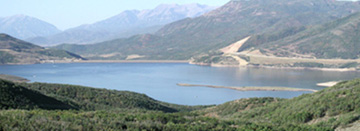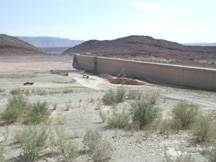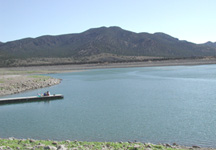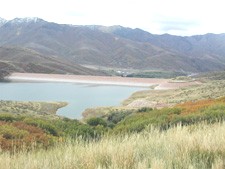Ending Water Year Reservoir Levels
Lower reservoir levels reflect the effects of current drought conditions.
October 3, 2002
|
|
One hundred miles further north, the Minersville Reservoir is down to 6 percent of its capacity. Located 16 miles west of Beaver, the reservoir level reflects the drought conditions in south-central Utah. Overall reservoir storage in this region of the state is extremely low. Sevier Bridge is 15 percent, Otter Creek 11 percent and Piute 4 percent full.
In the central-northern part of the state water storage is better than in the southern part of the state. Strawberry Reservoir, located approximately 50 miles east of Salt Lake City on SH 40, currently holds 73 percent of its water volume, down from 86 percent last water year. This reservoir, part of the Central Utah Project, stores water from the vast collection system situated along the Uinta Mountain range that diverts a portion of the state’s Colorado River allocation.
Jordanelle Reservoir located northwest of Heber City, is another feature of the Central Utah Project. At the end of the water year this reservoir contained approximately 240,000 acre-feet of water, which is 76 percent of its capacity. A major source of drinking water for the Wasatch Front, this project ensures an adequate water supply for the large population residing in Utah and Salt Lake counties.
|
It is estimated that the Metropolitan Water District of Salt Lake & Sandy will be able to holdover about 10,000 acre-feet of water for next year. According to general manager G. Keith Denos, rains in September reduced water demand and helped stop the water levels from dropping even further in Deer Creek. “We were projecting that the total volume in the reservoir would reach even lower values, but the downward trend stopped and then flatted out during September,” says Denos.
The water level in Little Dell Reservoir located 5-miles east of Salt Lake City has actually increased 49 percent from 9,224 acre-feet last year to 13,698 this year. Salt Lake City Department of Public Utilities credits water management and conservation for this increase. “In the event there is another year of drought and the need to protect Salt Lake City’s water customers from serious shortages, we have saved as much water as possible in Little Dell,” says public utilities deputy director Jeffery Niermeyer.
Weber Basin reservoir storage is 41 percent of capacity. Reservoir storage varies from a low of 22 percent in Pineview to a high of 75 percent in Smith & Moorehouse Reservoir. Pineview was purposely lowered by the Bureau of Reclamation this year to make repairs to the dam
In the far northern part of the state is Bear River Reservoir. Water volumes have decreased from 40 percent to 25 percent this past year. The overall average storage in the Bear River Basin is about 23 percent.
|
State water managers are hoping for a return of more normal precipitation and snowpack this coming winter. Regardless of favorable weather prognostications and hopeful wishes, water levels in Utah’s reservoirs are lower than normal as a new water year begins.



